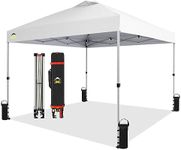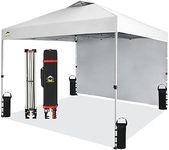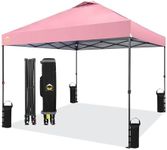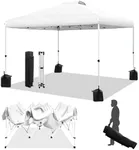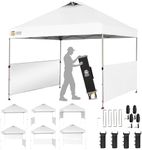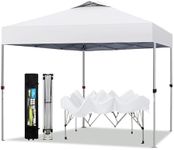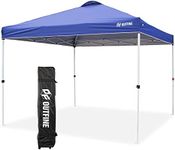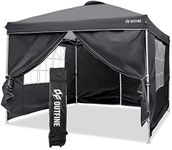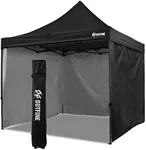Buying Guide for the Best 10x10 Canopy Tents
Choosing the right 10x10 canopy tent involves understanding your specific needs and how different features can meet those needs. Whether you're planning to use the tent for outdoor events, camping, or as a market stall, it's important to consider various specifications to ensure you get the best fit for your requirements. Here are some key specs to consider and how to navigate them.MaterialThe material of the canopy tent is crucial as it determines durability, weather resistance, and overall longevity. Common materials include polyester, polyethylene, and canvas. Polyester is lightweight and water-resistant, making it suitable for occasional use. Polyethylene is more durable and offers better water resistance, ideal for frequent outdoor use. Canvas is the most durable and offers excellent protection from the elements but is heavier and more expensive. Choose the material based on how often you plan to use the tent and the typical weather conditions you'll face.
FrameThe frame of the canopy tent provides the structure and stability. Frames are typically made from steel or aluminum. Steel frames are strong and sturdy, making them suitable for windy conditions, but they are heavier and prone to rust. Aluminum frames are lightweight, rust-resistant, and easier to transport, but they may not be as strong as steel. Consider the balance between portability and durability based on your usage. If you need to move the tent frequently, aluminum might be better, while steel is ideal for more permanent setups.
Water ResistanceWater resistance is important if you plan to use the canopy tent in rainy conditions. Look for tents with a high water resistance rating, often indicated by the hydrostatic head measurement (in millimeters). A rating of 1000mm to 1500mm is suitable for light rain, while 2000mm or higher is better for heavy rain. Additionally, check for features like sealed seams and waterproof coatings. Choose a tent with adequate water resistance based on the typical weather conditions in your area.
UV ProtectionUV protection is essential if you plan to use the canopy tent in sunny conditions. UV protection is usually indicated by the UPF (Ultraviolet Protection Factor) rating. A UPF rating of 30+ offers good protection, while 50+ provides excellent protection. This feature helps protect you and your belongings from harmful UV rays and can also prevent the tent material from degrading over time. Consider the level of sun exposure you expect and choose a tent with an appropriate UPF rating.
Ease of SetupEase of setup is important, especially if you plan to set up the tent frequently or by yourself. Look for features like pop-up designs, which allow for quick and easy setup without the need for tools. Some tents come with pre-attached frames and can be set up in minutes. Consider your own strength and the number of people available to help with setup. If you need a tent that can be set up quickly and easily, opt for a pop-up design.
WeightThe weight of the canopy tent affects its portability. Lighter tents are easier to transport and set up, making them ideal for events where you need to move the tent frequently. Heavier tents are generally more stable and durable, suitable for more permanent setups. Consider how often you will need to move the tent and the importance of stability in your specific use case. Choose a weight that balances portability and stability based on your needs.
SidewallsSidewalls provide additional protection from the elements and can offer privacy. Some tents come with detachable sidewalls, allowing you to customize the setup based on the weather and your needs. Sidewalls can be made from the same material as the canopy or from mesh for better ventilation. Consider whether you need sidewalls for protection from wind, rain, or sun, and choose a tent that offers the flexibility to add or remove sidewalls as needed.
Anchoring SystemThe anchoring system is crucial for the stability of the canopy tent, especially in windy conditions. Common anchoring systems include stakes, weights, and guy lines. Stakes are suitable for soft ground, while weights are better for hard surfaces like concrete. Guy lines provide additional stability by securing the tent to the ground. Consider the typical ground surface where you will set up the tent and choose an anchoring system that provides adequate stability for those conditions.
